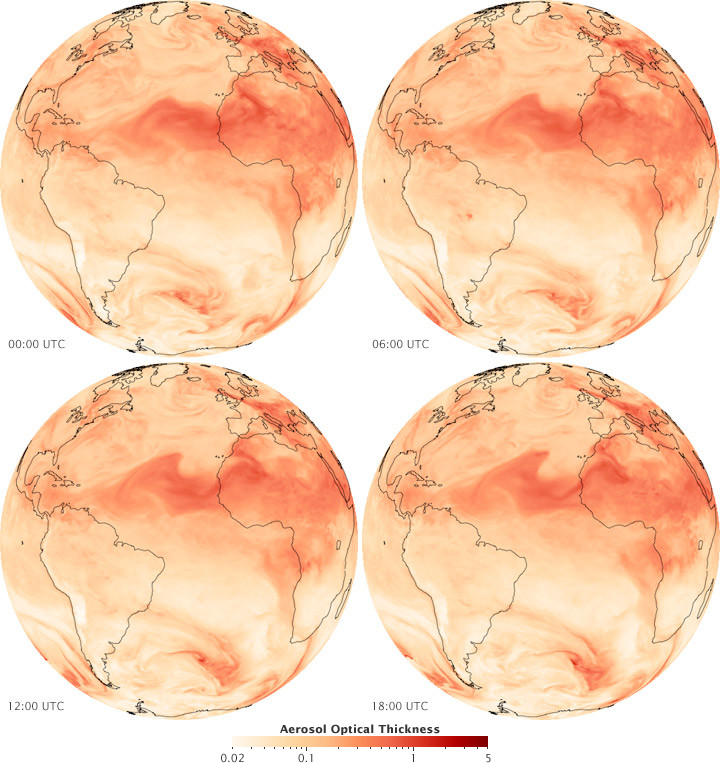


Tiny solid and liquid particles—scientists refer to them as aerosols—can be found in the air all over the world, and they have a global impact on weather and climate. There are many sources of aerosols, including smoke and pollution from human activities. One of the most abundant particles is the dust and sand that blows off of Earth's deserts.
This series of images, derived from a computer model, shows wind-blown dust from North Africa as it spread over the Atlantic Ocean on July 1, 2009. The model depicts aerosol optical thickness, a measure of the amount of light that the aerosols scatter and absorb, and a proxy for the number of particles in the air. An optical thickness of less than 0.1 indicates a clear sky with maximum visibility; a value of 1 or above indicates very hazy conditions. The time signatures in the model move in six-hour increments from midnight (00:00 Universal Time, or UTC) to 6 p.m. (18:00).
Although most aerosols remain suspended in the air for just short periods—typically between four days and a week—they can travel vast distances. Particles moving with the atmosphere at 5 meters (16.4 feet) per second will travel thousands of kilometers in a week.
Dust plumes from the Sahara frequently cross the Atlantic and reach the skies of the Caribbean. Scientists are particularly interested in the role of this dust transport in the formation of clouds and in influencing the development of hurricanes and typhoons.
As noted in our fact sheet, “Aerosols: Tiny Particles, Big Impact”:
Most elementary school students learn that clouds form when enough water vapor condenses. That’s true, but aerosols play a critical role in the process. In fact, most clouds owe their existence to aerosols that serve as the tiny “seeds,” called cloud condensation nuclei. Natural aerosols are the most common condensation nuclei in pristine environments.
The event depicted above comes from the Goddard Earth Observing System Model, Version 5 (GEOS-5), an atmospheric model used to study the physics of the atmosphere in both the short term (weather) and mid- to long term (climate). The GEOS-5 model uses mathematical equations that represent physical processes—such as precipitation and cloud processes—to calculate what the atmosphere will do. Actual measurements of physical properties like temperature, moisture, and winds are routinely folded in to keep the simulation as close to the real world as possible.
The millions of calculations involved in creating such a detailed global model require thousands of computer processors. The GEOS-5 model runs on the nearly 15,000 processors of the Discover supercomputer in the new NASA Center for Climate Simulation at Goddard Space Flight Center.
NASA maps by Pete Colarco and Robert Simmon, based on GEOS-5 model data. Caption by Mike Carlowicz and Adam Voiland.